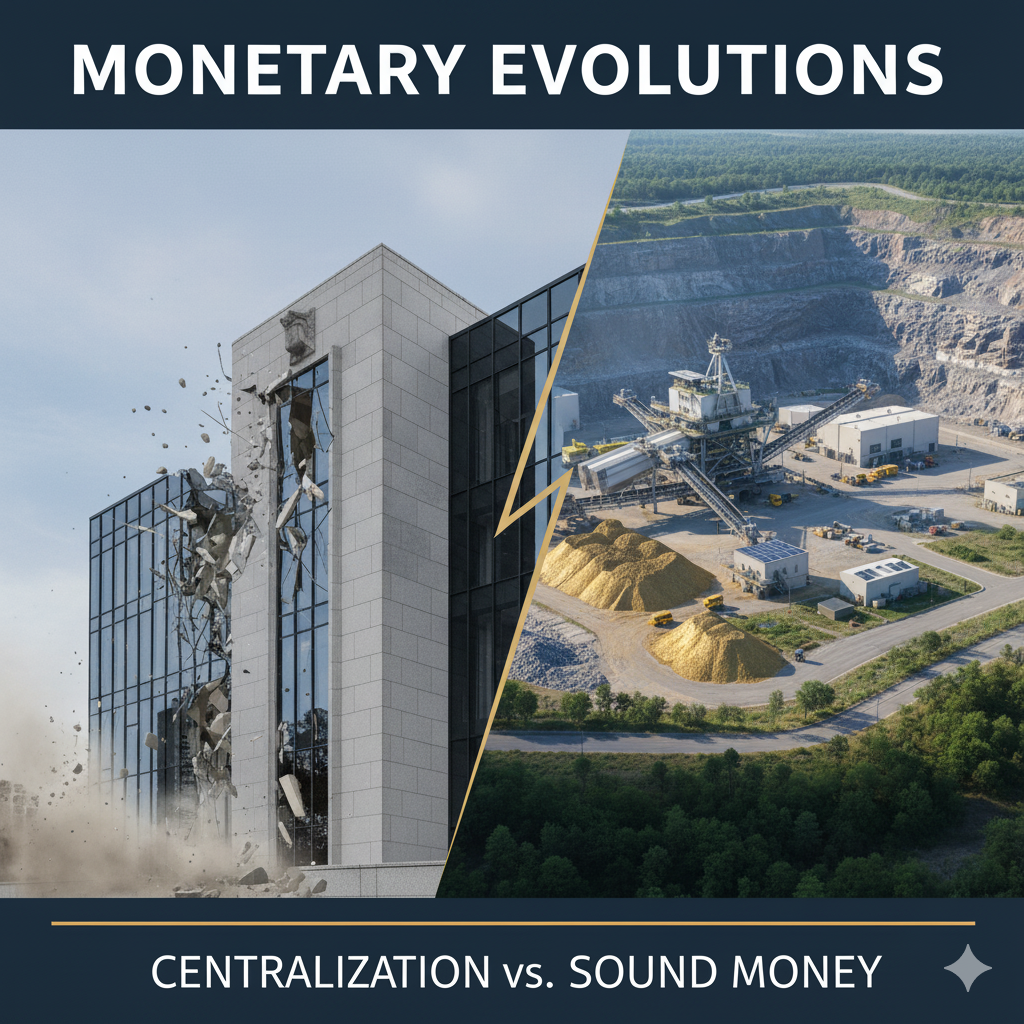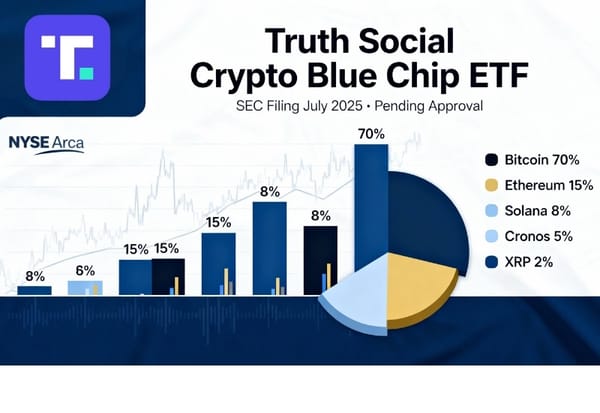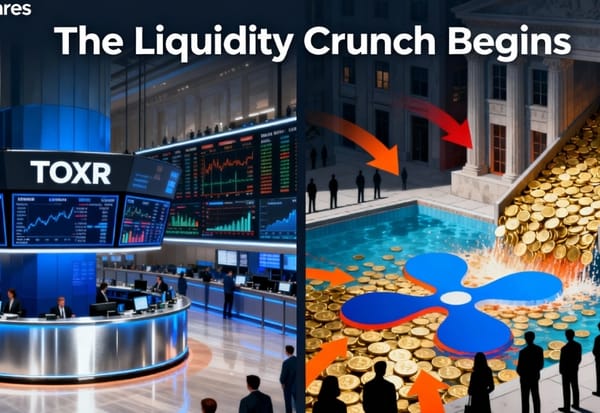Part II: Sectoral Revolution Without Central Banking
Eliminating the Federal Reserve while restoring precious metal standards would create the most dramatic sectoral revolution in American history. Historical analysis reveals mining stocks could gain 200-500% while Fed-dependent banks face 30-80% declines.

The Greatest Sectoral Transformation Since the Industrial Revolution
Key Insight: Eliminating the Federal Reserve while restoring precious metal standards would create the most dramatic sectoral revolution in American history, as industries dependent on central bank manipulation face extinction while those aligned with market forces experience unprecedented growth.
The simultaneous elimination of fiat money and central banking would affect every sector differently than precious metals restoration alone. Historical analysis of pre-Fed sectoral performance (1792-1913) versus Fed era distortions (1913-2024) reveals which industries thrive under market-based monetary systems versus central bank manipulation.
Banking Revolution: From Fed Dependency to Market Competition
The Federal Reserve's Banking Distortions
Current Banking Model: Banks operate as Fed transmission mechanisms rather than genuine financial intermediaries.
Fed-Dependent Operations:
- Fractional reserves are backed by the Fed's unlimited lending rather than genuine deposits
- Interest rate spreads are determined by Fed policy rather than market competition
- Government bond portfolios supported by Fed purchases rather than market demand
- Risk management relying on Fed bailouts rather than prudent lending practices
Systematic Moral Hazard: Too-big-to-fail policy creates reckless lending and excessive leverage impossible under market discipline.
Post-Elimination Banking Transformation
Market-Based Banking Characteristics:
- 100% reserve banking for demand deposits, eliminating fractional reserve fraud
- Time deposit competition for lending capital through genuine savings mobilization
- Interest rates are determined by supply and demand rather than Fed manipulation
- Risk assessment through market mechanisms rather than government guarantees
Historical Precedent: Scottish free banking (1716-1845) and Canadian branch banking (1817-1935) demonstrated superior stability and customer service compared to central bank systems [1].
Competitive Advantages:
- Community banks: Local knowledge and relationship banking become primary competitive advantages
- Credit unions: Member ownership aligns incentives better than shareholder-owned banks, dependent on Fed policy
- Private banks: Wealthy clientele demanding precious metals services and international capabilities
- Mutual savings banks: Conservative lending and deposit focus align with market-based banking
Banking Sector Investment Strategy
Winners (200-400% potential gains):
- Small community banks with strong local relationships and conservative management
- Credit unions with low leverage and member-focused operations
- Private banking specialists serving high-net-worth precious metals investors
- International banks with precious metals expertise and global operations
Transformation Candidates (50-150% gains if successful):
- Regional banks that successfully adapt to market-based operations
- Specialty banks focused on precious metals and commodity financing
- Technology banks providing digital services for precious metals transactions
Losers (50-80% declines):
- Money center banks are dependent on Fed funding and government bond trading
- Investment banks relying on Fed liquidity for proprietary trading
- Mortgage banks are dependent on Fed mortgage-backed securities purchases
- Banks with high leverage are unable to compete under market discipline
Federal Reserve's Industrial Policy Distortions
How Fed Policy Artificially Favors Certain Sectors
Fed Credit Allocation: Interest rate manipulation and quantitative easing systematically favor certain industries over others.
Beneficiaries of Fed Policy:
- Financial services: Cheap funding and yield curve manipulation benefit banking and investment management
- Real estate: Low interest rates artificially inflate property values and construction activity
- Technology: Venture capital funded by Fed-created liquidity rather than genuine savings
- Government contractors: Deficit spending enabled by Fed monetization rather than taxation
Victims of Fed Policy:
- Manufacturing: Cheap imports funded by dollar creation rather than genuine comparative advantage
- Agriculture: Input cost inflation from Fed monetary expansion while export competitiveness is undermined by a strong dollar
- Small business: Credit allocation favors large corporations with bond market access over bank-dependent small firms
- Savers and retirees: Interest rate suppression destroys traditional retirement income models
Manufacturing Renaissance Under Fed Elimination
Historical Context: American manufacturing peaked during the pre-Fed era (1879-1913) when sound money enabled long-term capital investment.
Fed Era Manufacturing Decline:
- Manufacturing employment fell from 27% of the workforce in 1950 to 8% in 2020 [2]
- Trade deficits are enabled by Fed dollar creation rather than economic adjustment
- Financialization displaced productive investment through cheap Fed credit
- Short-term focus encouraged by Fed policy uncertainty and cheap capital
Post-Fed Manufacturing Advantages:
- Stable money enables long-term capital investment and research and development
- Competitive currency reflects genuine productivity rather than Fed manipulation
- Patient capital replaces speculation as investment focus shifts to productive assets
- Trade balance adjustment forces import substitution and domestic production
Investment Opportunities:
- Capital goods manufacturers supplying precious metals infrastructure
- Machine tool companies supporting manufacturing renaissance
- Specialty manufacturers with pricing power and operational efficiency
- International manufacturers with competitive advantages under stable money
Technology Sector: From Fed Bubble to Genuine Innovation
Fed-Created Technology Distortions:
- Venture capital is inflated by Fed liquidity rather than genuine savings
- Unicorn valuations based on cheap capital rather than sustainable business models
- Stock buybacks funded by corporate borrowing at Fed-suppressed rates
- Subscription models are dependent on continuous access to cheap refinancing
Post-Fed Technology Transformation:
- Genuine innovation focus replaces growth-at-any-cost mentality
- Profitable business models are required from early stages rather than Fed-funded losses
- Hardware and infrastructure gain an advantage over software and services under deflationary conditions
- International competition intensifies without Fed-enabled dollar advantages
Winners in Technology:
- Precious metals infrastructure: Blockchain verification, custody systems, digital security
- Cybersecurity: Essential services for precious metals transactions and storage
- Hardware manufacturers: Physical assets and productive capability gain relative value
- Enterprise software: Productivity enhancement tools with genuine cost savings
Losers in Technology:
- Social media platforms are dependent on advertising and Fed-inflated valuations
- Streaming services with subscription models are under deflationary pressure
- Gig economy platforms are dependent on continuous venture funding and growth subsidies
Energy Sector: From Fed-Enabled Speculation to Fundamental Value
Fed Distortions in Energy Markets
Petrodollar System: Fed creation enabled oil pricing in dollars while exporting inflation to oil-importing countries.
Shale Oil Bubble: Fed credit expansion (2010-2020) enabled unprofitable shale production through cheap borrowing and high-yield bonds [3].
Renewable Energy Subsidies: Fed-enabled government spending artificially promoted renewables through tax credits and direct subsidies.
Post-Fed Energy Market Transformation
Oil Market Fundamental Changes:
- Pricing mechanisms shift from dollars to precious metals or commodity baskets
- Production decisions based on genuine profitability rather than Fed-enabled speculation
- International cooperation in energy trade without the dollar system advantages
- Strategic petroleum reserves potentially supplemented with strategic precious metals reserves
Natural Gas and Coal Revival:
- Domestic energy gains a competitive advantage as import financing becomes more expensive
- Coal production for industrial processes supporting precious metals extraction
- Natural gas for chemical processes and manufacturing renaissance
Renewable Energy Reality Check:
- Market-based pricing without government subsidies funded by Fed monetization
- Genuine cost-competitiveness requirements rather than artificial support
- Grid reliability becomes paramount without Fed-funded backup systems
- Energy storage is critical for renewable viability under market conditions
Investment Strategy:
- Conventional energy producers with low-cost production and strong balance sheets
- Energy infrastructure supporting domestic production and precious metals operations
- Coal producers serving steel production for precious metals infrastructure
- Renewable energy companies with genuine cost advantages and reliable technology
Real Estate: From Fed Inflation Hedge to Productive Asset
Fed Real Estate Distortions
Artificially Low Interest Rates: Fed policy systematically inflated real estate prices by reducing borrowing costs below market levels.
Mortgage Market Manipulation: Fed purchases of mortgage-backed securities created artificial demand and reduced lending standards [4].
Commercial Real Estate Bubbles: Fed liquidity enabled speculation in commercial properties through cheap financing and yield-seeking behavior.
Post-Fed Real Estate Fundamentals
Residential Real Estate Repricing:
- Property values reflect productive use and local economic fundamentals rather than Fed-created speculation
- Mortgage rates are determined by genuine savings and risk assessment rather than Fed manipulation
- Regional differentiation increases as local economic conditions matter more than Fed policy
- Affordability improvement through price adjustment rather than artificial credit expansion
Commercial Real Estate Transformation:
- Income-producing properties gain an advantage over speculative holdings
- Industrial real estate supporting precious metals infrastructure commands premium valuations
- Office buildings face adjustment as financial sector downsizing reduces space demand
- Retail properties benefit from increased consumer purchasing power under stable money
Agricultural Land Advantages:
- Food production gains strategic importance under a stable international monetary system
- Precious metals region agriculture benefits from mining industry support
- Export agriculture competitive advantages through a stable currency rather than Fed manipulation
Investment Approach:
- Focus on productive real estate rather than speculative properties
- Industrial properties supporting precious metals and manufacturing operations
- Agricultural land in politically stable regions with water rights
- International real estate in precious metals-friendly jurisdictions
Precious Metals Sector: The Ultimate Beneficiary
Central Role in Fed-Free Economy
Monetary Infrastructure: Precious metals become essential infrastructure for the monetary system operation rather than speculative investments.
Industrial Demand Explosion: Gold and silver are required for:
- Digital currency backing and verification systems
- International settlement mechanisms and trade finance
- Banking reserves and custody operations
- Technology infrastructure supporting precious metals transactions
Mining Sector Transformation
Production Scaling Requirements:
- Unprecedented demand for precious metals extraction to back the monetary system
- Technology advancement in mining efficiency and ore processing
- Geographic expansion to previously uneconomic deposits
- Integration with technology companies providing digital infrastructure
Investment Opportunities by Category:
Large-Cap Miners (Core Holdings - 300-500% potential):
- Newmont Corporation (NEM): The world's largest gold producer with global diversification
- Barrick Gold (GOLD): The
- Franco-Nevada (FNV): Royalty model providing exposure without operational risk
- Agnico Eagle Mines (AEM): High-quality operations in stable jurisdictions
Mid-Cap Producers (Growth Holdings - 400-700% potential):
- Kinross Gold (KGC): Cost-effective operations with expansion capabilities
- Yamana Gold (AUY): South American diversification and development pipeline
- Pan American Silver (PAAS): Largest silver producer with growth potential
- Hecla Mining (HL): American silver focus with operational leverage
Junior Miners and Exploration (Maximum Leverage - 500-1500% potential):
- Geographic focus: Canada, Australia, Nevada, Alaska, for political stability
- Resource quality: Measured and indicated reserves rather than speculative exploration
- Management teams: Proven development experience and operational expertise
- Financial strength: Balance sheets capable of surviving transition volatility
Precious Metals Infrastructure (New Sector - 200-800% potential):
- Refineries and processing: Johnson Matthey (JMPLY), BASF Precious Metals
- Storage and custody: Brinks (BCO), Loomis (LOOMF), Delaware Depository
- Trading and logistics: APMEX, JM Bullion, specialized precious metals dealers
- Technology integration: Blockchain verification, digital custody systems
Healthcare Sector: From Fed-Enabled Inflation to Market Pricing
Fed Healthcare Distortions
Cost Inflation: Fed monetary expansion enabled healthcare cost inflation far exceeding general inflation through third-party payment systems.
Insurance Model Distortions: Fed-enabled government spending on Medicare and Medicaid created artificial demand and pricing disconnection.
Pharmaceutical Inflation: Fed credit expansion enabled venture capital funding of drug development with high price expectations.
Post-Fed Healthcare Market Transformation
Price Transparency and Competition:
- Direct payment models emerge as insurance intermediaries face cost pressures
- Price competition develops without Fed-enabled cross-subsidization
- International competition in medical services and pharmaceuticals increases
- Preventive care becomes economically attractive under stable pricing
Medical Innovation Transformation:
- Drug development focuses on genuine medical needs rather than Fed-funded speculative ventures
- Medical device innovation driven by cost reduction and efficacy improvement
- Telemedicine expansion to reduce costs and improve access
- Alternative medicine gains market share through cost advantages
Investment Strategy:
- Efficient healthcare providers with direct payment models and cost control
- Medical technology companies focused on productivity improvement and cost reduction
- Pharmaceutical companies with essential medications and competitive production
- International healthcare companies serving medical tourism markets
Agricultural Transformation: From Fed Subsidies to Market Production
Fed Agricultural Distortions
Input Cost Inflation: Fed monetary expansion systematically increased the costs of fuel, fertilizer, and equipment faster than crop prices.
Export Competitiveness: A strong dollar from Fed policy made American agriculture less competitive internationally.
Subsidy Dependence: Government agricultural programs funded by Fed monetization rather than taxation created artificial market distortions.
Post-Fed Agricultural Renaissance
Cost Structure Improvement:
- Input costs stabilize or decline under deflationary monetary policy
- Equipment prices reflect genuine manufacturing costs rather than Fed-inflated asset values
- Labor costs adjust to market levels without Fed-created wage inflation
Export Competitiveness:
- Currency competitiveness reflects genuine agricultural productivity rather than Fed manipulation
- International trade benefits from stable exchange rates under precious metals standards
- Regional specialization develops based on natural advantages rather than subsidy distortions
Market-Based Production:
- Crop selection based on genuine demand and comparative advantage rather than government programs
- Efficiency improvements driven by market competition rather than subsidy dependence
- Technology adoption focused on genuine productivity gains rather than compliance requirements
Investment Opportunities:
- Efficient agricultural producers with competitive advantages and low debt levels
- Agricultural technology companies providing genuine productivity improvements
- Food processing and distribution companies serving domestic markets
- Agricultural land in regions with competitive advantages and precious metals proximity
Transportation and Logistics: Precious Metals Infrastructure
Fed Distortions in Transportation
Fuel Cost Volatility: Fed monetary policy created systematic fuel price instability affecting transportation economics.
Infrastructure Investment: Fed-enabled government spending on transportation infrastructure created artificial demand and cost inflation.
International Trade Distortions: Fed dollar policy affected international shipping and trade route economics.
Post-Fed Transportation Transformation
Precious Metals Logistics Boom:
- Secure transportation for physical precious metals has become a major industry
- International shipping adapted for the precious metals trade and settlement
- Railroad transport for mining operations and precious metals distribution
- Airport security and logistics for high-value precious metals cargo
Domestic Transportation Benefits:
- Fuel cost stability under sound money improves transportation economics
- Manufacturing renaissance creates increased freight demand
- Regional economic development supported by stable transportation costs
Investment Opportunities:
- Railroad companies serving mining regions and precious metals corridors
- Trucking companies specializing in secure transport and precious metals logistics
- Shipping companies with precious metals and commodity specialization
- Logistics technology companies serving the precious metals supply chain
Government and Municipal Finance Crisis
Fed-Enabled Government Expansion
Deficit Monetization: Fed purchases of government debt enabled spending without corresponding taxation or genuine borrowing.
Municipal Bond Support: Fed policy artificially supported municipal bonds through low interest rates and bank reserve requirements.
State and Local Dependency: Government entities became dependent on Fed-enabled federal transfers and cheap borrowing.
Post-Fed Government Fiscal Reality
Federal Government Constraints:
- Spending limited to taxation and genuine market borrowing rather than Fed monetization
- Interest payments on existing debt become a major budget constraint at market interest rates
- Program cuts are necessary as deficit financing becomes impossible or extremely expensive
- Constitutional government restored through fiscal discipline and spending accountability
State and Local Crisis:
- Municipal bonds face market pricing without Fed support and federal transfer reductions
- Pension obligations become unsustainable without Fed-enabled investment returns and federal bailouts
- Public employee unions face the reality of fiscal constraints and market-determined compensation
- Tax base erosion is a problem as high-tax jurisdictions lose competitiveness without federal support
Investment Implications:
- Avoid government bonds at all levels due to fiscal unsustainability
- Focus on private sector companies and productive assets
- Geographic arbitrage toward low-tax, fiscally responsible jurisdictions
- International diversification away from government-dependent sectors
Sectoral Investment Summary: Fed Elimination Winners and Losers
Maximum Winners (300-1000% gains potential)
Precious Metals Mining: Direct beneficiaries of the unprecedented demand for a monetary system backing
Technology Infrastructure: Companies providing digital infrastructure for precious metals systems
Community Banking: Local banks with competitive advantages under market-based banking
Domestic Manufacturing: Companies benefiting from currency competitiveness and stable money
Precious Metals Services: Storage, custody, transportation, and verification services
Transformation Winners (100-300% gains if successful)
Energy Producers: Efficient companies adapting to fundamental value pricing rather than Fed speculation
Agricultural Producers: Competitive farms benefiting from cost structure improvement and export competitiveness
Healthcare Efficiency: Companies providing cost-effective medical services under market pricing
Real Estate Productive Use: Income-producing properties and industrial real estate supporting the precious metals economy
International Companies: Businesses adapting to precious metals standards and currency competition
Major Losers (50-80% declines)
Federal Reserve System: Complete elimination of central banking infrastructure and employment
Government Bond Complex: Treasury dealers, Fed primary dealers, and government bond funds
Fed-Dependent Banking: Money center banks and institutions dependent on Fed funding and policy support
Financial Engineering: Companies dependent on Fed credit and manipulation rather than genuine productivity
Government Contractors: Businesses dependent on Fed-enabled deficit spending rather than taxation-funded programs
Requires Fundamental Adaptation
Technology Growth Companies: Must transition from Fed-funded growth to genuine profitability and sustainable business models
Real Estate Investment: Speculative properties face major adjustment, while productive real estate gains relative value
Consumer Finance: Credit-dependent businesses face contraction while cash-based operations gain advantages
International Trade: Companies must adapt to precious metals settlement and competitive currency rather than the Fed dollar advantages
Conclusion: The Greatest Sectoral Revolution in American History
The simultaneous elimination of the Federal Reserve and restoration of precious metal standards would create the most dramatic sectoral transformation since the Industrial Revolution.
Key Investment Principles:
- Fed elimination amplifies precious metals opportunities beyond simple monetary transition by eliminating competitive institutions and restoring market mechanisms
- Historical precedent supports optimism for sectors that thrived during pre-Fed era (1792-1913) when American economy grew faster and more sustainably
- Competitive advantages shift from Fed-manipulation skills to genuine operational efficiency and productive capability
- International diversification becomes crucial as currency competition replaces Fed dollar dominance
- Timing matters enormously, as early positioning in winning sectors could generate life-changing returns while late adaptation risks devastating losses
The sectoral revolution would be swift and decisive, with most transitions completing within 24-36 months of the Fed elimination announcement. Successful investors must position before widespread recognition rather than waiting for confirmation.
Sources and References
[1] White, Lawrence H. Free Banking in Britain: Theory, Experience and Debate, 1800-1845. Cambridge University Press, 1984.
[2] Bureau of Labor Statistics. "Employment by major industry sector." https://www.bls.gov/emp/tables/employment-by-major-industry-sector.htm
[3] Energy Information Administration. "Annual Energy Outlook 2024." https://www.eia.gov/outlooks/aeo/
[4] Federal Reserve Bank of St. Louis. "Federal Reserve holdings of agency- and GSE-backed securities." https://fred.stlouisfed.org/series/WSHOMCB
Previous Article: Part I: Historical Foundations and Federal Reserve Elimination
Next Article: Part III: Transition Scenarios and Federal Reserve Elimination Implementation# Part II: Sectoral Revolution Without Central Banking



